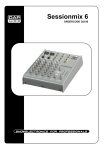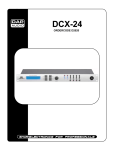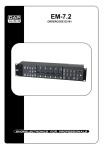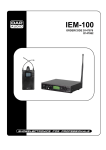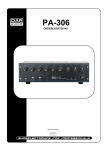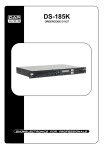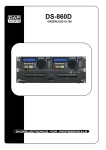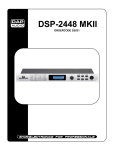Download Powermix 1
Transcript
Powermix 1 ORDERCODE D2221 Congratulations! You have bought a great, innovative product from DAP Audio. The DAP Audio Powermix 1 brings excitement to any venue. Whether you want simple plug-&-play action or a sophisticated show, this product provides the effect you need. You can rely on DAP Audio, for more excellent audio products. We design and manufacture professional audio equipment for the entertainment industry. New products are being launched regularly. We work hard to keep you, our customer, satisfied. For more information: [email protected] You can get some of the best quality, best priced products on the market from DAP Audio. So next time, turn to DAP Audio for more great audio equipment. Always get the best -- with DAP Audio ! Thank you! DAP Audio DAP Audio Powermix 1™ Product Guide Warning..…...................................................................................………………………………………….. Safety-instructions………………………………………………………………………………………….…. Operating Determinations……………………………………………………………………………………. 2 2 3 Description..…..............................................................................……….………………………………… Features………………………………………………………………………………….………………….…. Overview ..…………………………………………………………………………………….………....……. Frontside.………………………………………………………………………….………....………………... Backside.………………………………………………………………………….………....……………..…. 4 4 4 5 7 Installation...............................................................................…...……………………………………..…. 7 Set Up and Operation.....................................................................……..…………………………….….. Set Up ……………….............................................…………………………………...................……..... 13 13 Connection Cables..............................….......................................………..………….…….………….…. 14 Maintenance………..............................….......................................………..………….…….………….…. 15 Troubleshooting………..............................…................................………..………….…….………….….. 15 Product Specifications.................................................................……………….…….………………….. 16 1 WARNING CAUTION! Keep this system away from rain and moisture! FOR YOUR OWN SAFETY, PLEASE READ THIS USER MANUAL CAREFULLY BEFORE YOUR INITIAL START-UP! SAFETY INSTRUCTIONS Every person involved with the installation, operation and maintenance of this system has to: be qualified follow the instructions of this manual CAUTION! Be careful with your operations. With a dangerous voltage you can suffer a dangerous electric shock when touching the wires! Before you initial start-up, please make sure that there is no damage caused by transportation. Should there be any, consult your dealer and do not use the system. To maintain perfect condition and to ensure a safe operation, it is absolutely necessary for the user to follow the safety instructions and warning notes written in this manual. Please consider that damages caused by manual modifications to the system are not subject to warranty. This system contains no user-serviceable parts. Refer servicing to qualified technicians only. IMPORTANT: The manufacturer will not accept liability for any resulting damages caused by the non-observance of this manual or any unauthorized modification to the system. • • • • • • • • • • • • • Never let the power-cord come into contact with other cables! Handle the power-cord and all connections with the mains with particular caution! Never remove warning or informative labels from the unit. Never use anything to cover the ground contact. Never leave any cables lying around. Do not insert objects into air vents. Do not connect this system to a dimmerpack. Do not switch the system on and off in short intervals, as this would reduce the system’s life. Do not open the device and do not modify the device. Do not drive the inputs with a signal level bigger, than required to drive the equipment to full output. Do not plug Mics into the console (or stagebox) while Phantom Power is on. Also mute the monitor / Pa system when turning Phantom Power on or off. Allow the system to adjust for a couple of seconds, before setting the input gains. Only use system indoor, avoid contact with water or other liquids. Avoid flames and do not put close to flammable liquids or gases. Always disconnect power from the mains, when system is not used. Only handle the power-cord by the plug. Never pull out the plug by tugging the power-cord. 2 • • • • • • • • • • • • • • • • • Always operate the unit with the AC ground wire connected to the electrical system ground. Make sure you don’t use the wrong kind of cables or defective cables. Make sure that the signals into the mixer are balanced, otherwise hum could be created. Make sure you use DI boxes to balance unbalanced signals; All incoming signals should be clear. Make sure that the available voltage is not higher than stated on the rear panel. Make sure that the power-cord is never crimped or damaged. Check the system and the power-cord from time to time. In system setup, the amplifier's output power must be 50%-100% more than the loaded loudspeakers rated power. Please turn off the power switch, when changing the power cord or signal cable, or select the input mode switch. Extreme frequency boosts in connection with a high input signal level may lead to overdriving your equipment. Should this occur, it is necessary to reduce the input signal level by using the INPUT control. To emphasize a frequency range, you don’t necessarily have to move its respective sliding control upward; try lowering surrounding frequency ranges instead. This way, you avoid causing the next piece of equipment in your sound path to overdrive. You also preserve valuable dynamic reserve (“headroom”) Avoid ground loops! Always be sure to connect the power amps and the mixing console to the same electrical circuit to ensure the same phase! If system is dropped or struck, disconnect mains power supply immediately. Have a qualified engineer inspect for safety before operating. If the system has been exposed to drastic temperature fluctuation (e.g. after transportation), do not switch it on immediately. The arising condensation water might damage your system. Leave the system switched off until it has reached room temperature. If your Dap Audio device fails to work properly, discontinue use immediately. Pack the unit securely (preferably in the original packing material), and return it to your Dap Audio dealer for service. Repairs, servicing and electric connection must be carried out by a qualified technician. For replacement use fuses of same type and rating only. WARRANTY: Till one year after date of purchase. OPERATING DETERMINATIONS If this system is operated in any other way, than the one described in this manual, the product may suffer damages and the warranty becomes void. Any other operation may lead to dangers like short-circuit, burns, electric shock, etc. You endanger your own safety and the safety of others! Improper installation can cause serious damage to people and property ! 3 Description of the device Features The Powermix 1 is a powermixer from Dap Audio. • 24-bit DSP effect • 6 mono and 4 stereo inputs • LCD Display • High-quality faders • High-quality sealed potentiometer • Rugged design power supply ensures superior signal integrity • 2 groups Output • Stereo Master Amplifier 1xL und 1xR • Mono Monitor Amplifier Overview Fig. 1 4 Frontside 1) Mic Input (balanced) 2) Line Input (mono) 3) Gain range for Mic –40 / +10 dBu; range for Line -20 / +40 dBu 4) EQ Hi, range -15 / +15 dB 5) EQ Mid, range -15 / +15 dB 6) EQ Low, range -15 / +15 dB 7) Aux 0-10 (scale) 8) FX 0-10 (scale) 9) Pan, range L / R 10) Peak LED 11) Signal LED 12) Mono Channel 1-6 Fader Stereo Channel 7-10 Fader 5 13) Aux Fader controls 48 14) Mono Out Fader controls 47 15) Monitor Fader controls monitor amplifier output 16) Master Fader L (amplifier) 17) Master Fader R (amplifier) 18) 7-band Graphic equalizer 19) 2 Track to AUX mix (13) 20) 2 Track Ret controls 46, range 0-10 21) Phones controls 52, range 0-10 22) LED VU Meter 23) Main to Monitor / Aux to Monitor 24) Digital FX1 Display 25) Digital FX2 Display 26) Limit LED 27) Protect LED 28) Power LED 29) Down FX1 30) Up FX 1 31) Down FX2 32) Up FX2 33) FX 1, range 0-10 34) Aux 1, range 0-10 35) Fx 1 On/Off 36) FX 1 LED 37) Fx 2 On/Off 38) FX 2 LED 39) FX 2. range 0-10 40) Aux 2, range 0-10 41) Stereo 7-8 and L/mono 42) R 43) Stereo 9-10 and L/mono 44) R 45) Record Send L/R 46) 2 Track Return L/R 47) Mono Output 48) Aux 49) Main Output L/R 50) Power Amp Inputs L/R 51) FX 1/2 Footsw (ON/OFF) 52) Phones 6 Backside 53) IEC Connector 54) Power On/Off 55) Speakers Monitor 56) Speakers Right 57) Speakers Left 58) Main Fuse T6.3A/ L /250V 59) Ground Installation Remove all packing materials from the Powermix 1. Check that all foam and plastic padding is removed. Connect all cables. Always disconnect from electric mains power supply before cleaning or servicing. Damages caused by non-observance are not subject to warranty. Mono Input Channels Channels 1-6 are mono, with a choice of balanced Mic or Line inputs. Stereo Input Channels A further 4 Line inputs are configured as 2 stereo input channels. These are ideal for accepting outputs from MIDI and other electronic instruments. 7 1. MIC Electronically balanced XLR-type inputs for connecting low-impedance microphones. The input provides extremely low noise and low hum signal processing. When connecting a microphone make sure that the pin assignment is correct. Always make sure to read the manual of the microphone you want to connect. The XLR-inputs are not suitable for connecting an additional mixing console, FX-unit, etc. You have to use the LINE-inputs, when connecting this kind of equipment. 2. LINE Electronically balanced inputs for the connecting a keyboard, CD player , mixer, etc. You can connect balanced or unbalanced signal sources to the Line input. Do not connect signal devices to a channel’s MIC and LINE input at the same time, This will cause mutual interference, which results in level reduction. Note: When connecting signal sources, please make sure that the corresponding channel faders and the master faders are at their minimum settings. Otherwise unpleasant plug-in noise can occur. 3. GAIN Mic Channel input level is determined by the Gain control. With the Gain control you can adjust the MIC or LINE input-sensitivity, while optimally matching the incoming signals to the mixer’s internal operation level. When dealing with very low input levels (example vocal recordings or distant sound sources) the high gain is extremely profitable. How to set the Input level: 1) Set the gain control and the corresponding channel fader to their minimum setting. 2) Connect the desired sound source (CD player, microphone, ect) to the corresponding MIC or LINE input. 3) Play the sound source at its highest volume setting; respectively, sing or speak as loud as possible directly into the microphone. 4) While doing so, adjust the input level using the gain control, so that during the loudest passages the PEAK LED is just not lit, but the SIGNAL-LED lights constantly. This basic channel setting leaves you at least 8dB headroom. This means, you have at least 8dB before signal clipping. If you want to make further adjustments to the channel’s EQ setting, you should repeat step 3 and 4 again. 4 / 5 / 6 Equalizer SECTION (HI / MID / LOW) The mixer’s Equalizer section allows shaping of the incoming audio signal. All mono input channels are fitted with 3-band EQ. The upper (4) and lower (6) shelving controls have their frequencies fixed at 12 Khz and 80 Hz respectively. The Mid range control (5) has a peaking response frequency at 2.5 Khz. All 3 bands have up to 15 dB cut and boost, with a centre detent for “OFF”. Turning the Equalizer level control to the right amplifies the frequency range, turning to the left attenuates the signal. Minor changes to the Equalizer control usually produce the best results. Try to avoid excessive enhancement of the MID band. 7. AUX The Aux control allows you to change the Aux Channel to the Aux Mix. The range is from 0 – 10 8 8. FX The FX control allows you to change the FX Level to the FX Mix. The range is from 0 – 10 Using the FX1/2 control lets you route the corresponding input signal to the integrated digital effects units FX1 or FX2 at variable levels. In this way assigning special effects to musical instruments or vocals is fairly simple. When establishing an effect-mix, it is good advice to start with all FX-controls set to their center position. From this point you can increase or reduce the effect’s intensity, depending on your personal preferences. Please make sure to carefully monitor the PEAK LED’s in the FX1/2 channels during a performance. The indicator should only light briefly at the occurrence of peak signals. If the LED lights constantly, it is strongly recommended to lower the affected channels’ send levels at their FX1/2 controls. For further information, please refer also to the paragraphs on the FX1/2 units. 9. PAN By using the PAN control you can change the input signal’s position within the stereo image. When the PAN control is set to center position, the audio signal is equal for both the left and right buss. 10. PEAK Indicator The Peak indicator shows a channel’s incoming signal level at all times. If the red PEAK LED frequently blinks or constantly lights, the corresponding channel is likely to enter clipping and you have to reduce amplification using the gain control. The peak LED lights at a level of 8 dB below the occurrence of overdrive. Make sure that the Peak LED (+12dB) lights only briefly during dynamic peaks, indicating a state of over modulation (distortion at extremely high volumes). In this case, check the output signal of your mixer and turn down the input gain control. a channel LED (12) illuminates, when a channel is going into overload. You don’t want the overload light to come on, except very intermittently during a take or mix. If it does not light persistently, reduce input gain. 11. SIGNAL Indicator The Signal indicator shows a channel’s incoming signal level at all times. The green Signal LED will according to the rhythm of the incoming signal. If not, you should increase the input level by using the gain control. The Signal LED lights 30dB below clipping. 12. Channel Fader A high-quality true logarithmic 60mm fader, which controls the volume of a single channel and to establish an accurately proportioned mix of all input signals. The channel faders should be positioned within the range of -5dB to 0dB, leaving you with sufficient room to allow precise matching of differences in the channel’s level settings. The overall volume is set with the master fader. Even though the channel faders offer an additional gain of +10dB, it is better not to exceed the +5dB position. 9 13. AUX Fader A high-quality true logarithmic 60mm fader, which controls the Aux output level (48). 14. MONO OUT Fader A high-quality true logarithmic 60mm fader, which controls the Mono output level (47). 15. MONITOR Fader A high-quality true logarithmic 60mm fader, which controls the monitor amplifier output level (55). 16 / 17. MASTER Fader A high-quality true logarithmic 60mm fader, which controls the Left and Right amplifier output levels (56+57). LEFT and RIGHT Stereo fader for adjusting the overall volume as well as the output level of the internal power amplifiers and the MASTER A OUTPUTS (49). Please, make sure to close the fader of the corresponding input channel or at least the MASTER controls before connecting any audio signal sources. This will save yourself, your audience, and your equipment from unnecessary stress resulting from plug-in noise. 18. 7-BAND EQUALIZER All 7 frequency bands (80Hz, 250Hz, 630Hz, 2,5 KHz, 4 KHz, 8 KHz, 16 KHz) provide a ±12dB amplification/attenuation. You can change the overall sound, thus meeting your requirements for different locations. If you want your sound to have more bass, you have to boost the low frequency range, using the 80Hz or the 250Hz controls. If you experience too much bass, lower the levels of the 80Hz and 250 HZ controls. If the mid-range sounds a bit nasal, try attenuating the 630 Hz, 2,5 Khz and 4 Khz controls by some decibels. If you want to have a clear and highly intelligible sound, you should increase the level setting of the 8kHz or 16kHz band a bit. When using the equalizer, less attenuation is better than a great change of the control settings. 19. 2 Track to Aux adds 13 to the AUX mix, range 0-10 20. 2 Track Ret 2 Track Ret controls 45, range 0-10 21. Phones This control allows you to adjust the headphones’ volume. Phones controls 52, range 0-10 Caution: Depending on the type of headphones connected to the phones jack, the Powermix is capable of producing very high output levels via the phones output. Therefore, make sure to turn the control all the way to the left (minimum setting) before connecting the headphones. Be aware of the fact that listening to loud sound pressure levels over a longer period of time leads to hearing-damage! 22. LED VU Meter 23. Main to Monitor / Aux to Monitor This button allows you to choose between Main to Monitor / Aux to Monitor. Button pressed in, is Aux to Monitor. Button pressed out, is Main to Monitor 10 24 – 40 FX Section 24. Display FX1 You can change the FX 1 range by choosing one of the 16 available effects. You can alter the effect by pressing the Up (29) or Down (30) buttons. The display always indicates the actually selected program number for the corresponding FX-unit. 25 Display FX2 You can change the FX 2 range by choosing one of the 16 available effects. You can alter the effect by pressing the Up (31) or Down (32) buttons. 26. LIMIT LED When the red Limit LED blinks, means the internal power amplifiers are operated at their limits. Occasional blinking of the LED is acceptable, since the amplifiers’ limiters prevent distortion. Continuous lighting indicates that degradation in the outputted sound is likely to happen. In that case, you should reduce the master level. 27. PROTECT LED The red Protect LED lights when one of the power amplifiers’ extensive protection functions - against thermal overload, HF-induction, DC at the outputs, and SOAR-protection - is activated. When the PowerMix 1 is in protect mode, the speaker outputs are muted and the inputs of the power amplifier are short-circuited to prevent the amplifiers from being damaged. In this case you should first check if the frontal and/or rear ventilation louvers are blocked. Another cause for the activation of the protect functions might be, that you have connected more than two 8 Ohms speaker systems per power output. Please also disconnect the SPEAKON connectors and check the speaker cables for short circuit. During the power-on operation, the PROTECT LED always lights for about two seconds. This is normal. It indicates that the PowerMix’s protection circuitry is operational. 28. POWER LED The blue Power LED lights when the PowerMix is turned on. If, after switching the PowerMix on, the LED does not light, make sure that the mains plug is plugged in correctly. If the LED still doesn’t light up, please contact your DAP Audio dealer. 29 / 30 UP/DOWN FX1 The UP/DOWN-keys let you step through the effect programs one by one in increasing or declining order. Keeping either one button pressed for a longer period of time allows scrolling the effect program numbers with increased tempo. 31 / 32 UP/DOWN FX1 33. FX 1 You can change the FX value. The range is variable from 0 – 10. 34. AUX 1 You can change the AUX value. The range is variable from 0 – 10. 35 / 36. FX 1 On/Off You can press the FX 1 button (35) to turn this section on. When the button is pressed the green LED (36) lights up. It is recommended to switch the FX-units off during announcements. 11 37 / 38. FX 2 On/Off You can press the FX 2 button (37) to turn this section on. When the button is pressed the green LED (38) lights up. It is recommended to switch the FX-units off during announcements. 39. FX 2 You can change the FX value. The range is variable from 0 – 10. 40. AUX 2 You can change the AUX value. The range is variable from 0 – 10. 41) Stereo 7-8 and L / mono 42) R 43) Stereo 9-10 and L / mono 44) R 45) Record Send L/R These connectors carry the MASTER pre-fader audio signal, which means that the setting of the master fader doesn’t affect the level of the audio signal that is present at the RECORD SEND connectors, which let you connect a CD/MD recorder or TAPE/DAT deck. The nominal level of -10dBV at this output is suitable for professional use as well as for home recording purposes. 46) 2 Track Return L/R 47) Mono Output (controlled by Fader 15) 48) Aux 49) Main Output L/R Impedance-balanced outputs for the connection of external gear. The outputs are carried out as stereo phone-type jacks. Whenever possible use balanced cables. Balanced cabling is the best method for avoiding problems with interference and humming. 50) Power Amp Inputs L/R It is also possible to only use the amplifier in the Powermix 1 51) FX 1/2 Footsw You can connect a Footswitch to this jack. The footswitch makes it easy to switch between singing/playing with an effect and talking to a croud without changing the effect settings on your mixer. Simply push the footswitch and you can talk without an effect examp Delay, Hall, etc an instant. 52) Phones You can connect a pair of headphones with an impedance of 32 - 600 Ohm to this Stereo Phones jack. Balanced 1/4” TRS socket, wired as Tip=left, Ring=right and sleeve = ground. 12 Set Up and Operation Before plugging the unit in, always make sure that the power supply matches the product specification voltage. Do not attempt to operate a 120V specification product on 230V power, or vice versa. Set Up Set Up example 13 Connection Cables Take care of the connector cables, always holding them by the connectors and avoiding knots and twists when coiling them: This gives the advantage of increasing their life and reliability, which is always to your advantage. Periodically check that your cables are in good condition, that they are correctly wired and that all their contacts are perfectly efficient: a great number of problems (faulty contacts, ground hum, discharges, etc.) are caused entirely by using unsuitable or faulty cables. Headphones Unbalanced mono 1/4” jack plug Balanced mono 1/4” jack plug Compensation of interference with balanced connections 14 Maintenance The DAP Audio Powermix 1 requires almost no maintenance. However, you should keep the unit clean. Disconnect the mains power supply, and then wipe the cover with a damp cloth. Do not immerse in liquid. Do not use alcohol or solvents. Keep connections clean. Disconnect electric power, and then wipe the DMX and audio connections with a damp cloth. Make sure connections are thoroughly dry before linking equipment or supplying electric power. Troubleshooting DAP Audio Powermix 1 This troubleshooting guide is meant to help solve simple problems. If a problem occurs, carry out the steps below in sequence until a solution is found. Once the unit operates properly, do not carry out following steps. 1. If the device does not operate properly, unplug the device. 2. Check power from the wall, all cables, the fuse, etc. 3. If all of the above appears to be O.K., plug the unit in again. 4. If nothing happens after 30 seconds, unplug the device. 5. Return the device to your DAP Audio dealer. 15 2004 Dap Audio.



















